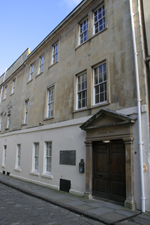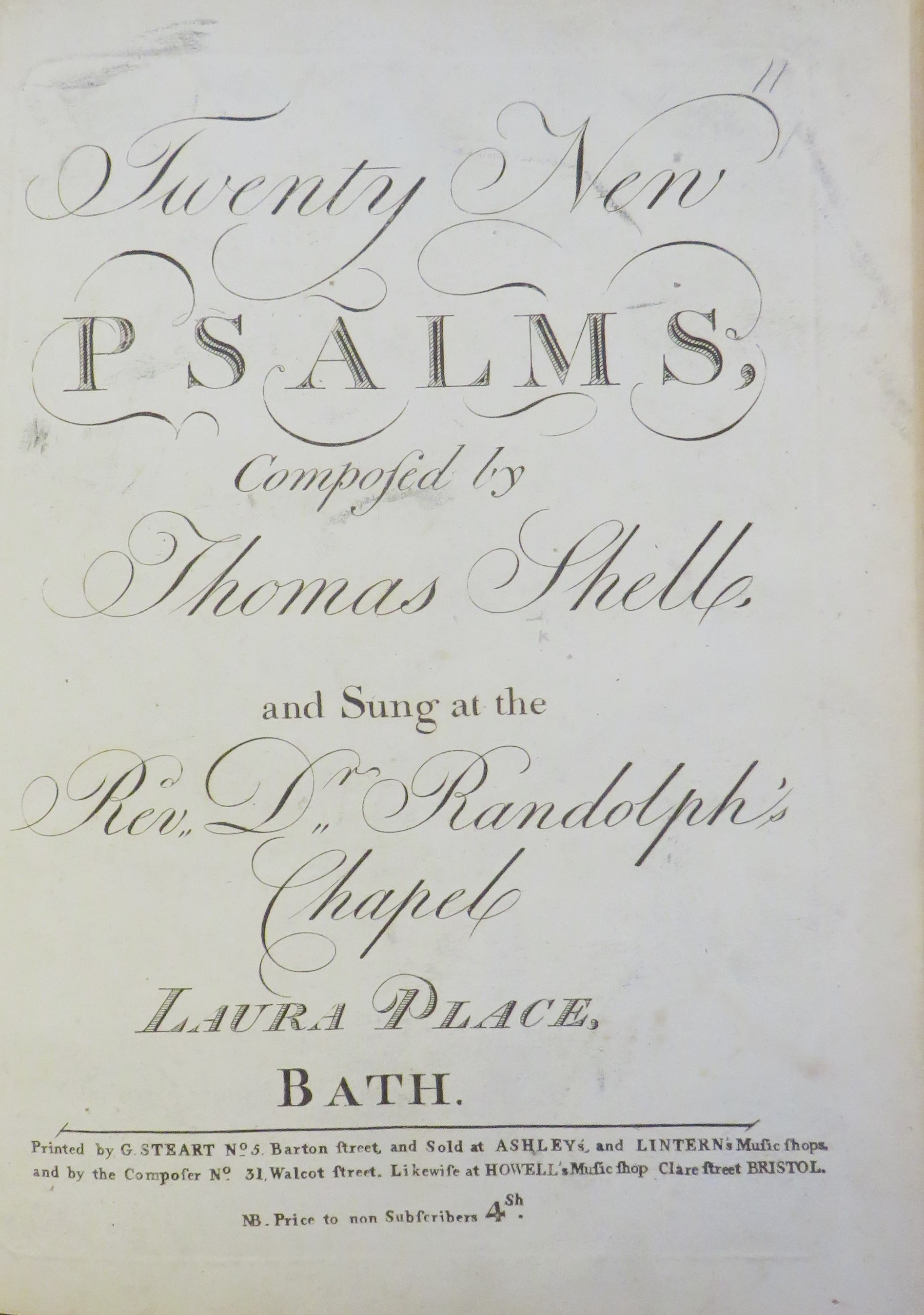

DoB unknown – 1st May 1801. CHILD STAR, COUNTER TENOR, ORCHESTRAL MUSICIAN AND COMPOSER Relation to me: 4 x great grandfather through my father.
MARRIAGE No.1 1789 During this time, Thomas was also developing his skills on the double bass and his voice changed to being a counter tenor. He had to make the transition from being a child star to a serious musician in one of the keenest musical environments there was at the time.
In private his life was about to change because on Tuesday May 5th 1789 Thomas married Ruth Elizabeth Charmbury at St Mary’s Church (now no longer in existence).
She went by her middle name as is seen by the announcement in the paper. This was clearly considered worthy local news of interest as it is included within a series of other announcements ranging from a few deaths to a huge sturgeon being sold at Bristol market!
HERSCHEL AND SHELL In the May of 1791, Thomas was involved in another concert and this is the first mention we have of him playing the double bass although he probably played in concerts before this. In the same orchestra was Alexander Herschel, the brother of William and Caroline. All three of the Herschel children possessed a remarkable talent in both music and things mechanical. Although William went on to achieve fame in the world of astronomy, both Caroline and Alexander spent precious hours grinding and polishing lenses and helping their brother in his quest. When William and Caroline moved from Bath, Alexander stayed and made it his home, continuing to play in the theatre orchestra and gaining a reputation as a fine cellist.
One can but speculate about any friendship between Alexander and Thomas, however, Alexander was known to suffer from bouts of depression and although he was twice engaged, he was jilted both times which didn’t help his demeanour! He may have been companionable with Thomas or a silent musical partner.
THE LOYAL PETITIONS During this period two events conspired to give anxiety to England. The first was that George III was suffering from what was called ‘The King’s condition’. This was his ‘madness’ possibly caused by Porphyria. This brought into question his ability to rule. At the same time, there was revolution in France and a question mark over the need for a monarch at all.
Thomas Paine had published his pamphlet ‘The Rights of Man’ which was considered seditious at the time. What is now considered a classic piece of democracy was considered most dangerous. It quickly became illegal to sell or own a copy.
In Bath, like elsewhere, the leaders of the city were nervous about gatherings of large people in case some sort of discussion about revolution gained ground. In 1792 they created Loyal Associations asking local traders and professionals to sign to show their allegiance to the King. Anybody who refused to sign could very quickly find themselves ostracised and their living compromised.
It is probably no surprise to see that Thomas signed it. To my mind he was already ensconced within the upper echelons of society through his music making. It would be madness for him to put that into jeopardy and I suspect he may even have upheld the values of the class within which he moved. What is interesting is that a ‘William Shell’ has also signed, just above Thomas. So far I have no evidence this is a relation and there were a number of Shells living in the Bath area during this period. This name is not associated with the Shell family either and often you find names coming down through the family line – as indeed the name Thomas has.
1793 DEATH OF WIFE AND A NEW ONE WITHIN WEEKS In October 1793 Elizabeth died. There are no children recorded for this marriage so it is highly likely she died in childbirth. She was buried in St Mary’s Chapel on 27th October 1793. When the chapel was pulled down in 1875, there is no record of what happened to the gravestones.
On December 1st 1793, Thomas re-married Hester Wight. The marriage certificate is quite hard to decipher but shows that both bride and husband could write as they have signed their names. I can’t quite read the witnesses – always something to look at as often they were family or significant friends of the couple.
One anomaly is that on the marriage certificate she is referred to as Hester, but elsewhere, she comes out as being Esther. I will go with the marriage certificate which was scribed by educated clerks, however, it is worth bearing this in mind.
The couple went on to have 6 children, 4 of whom survived to adulthood. Their first son Thomas was born in the May/June of the following year, which means that by the time of marriage, Hester was already pregnant. As conception would be at about the time Elizabeth died, this throws up several intriguing thoughts.
It is not uncommon to find throughout family ancestry the same kind of story repeated. Perhaps not this particular scenario, but children born out of wedlock and the couple then going on to marry, and certainly the bride having conceived before marriage took place. With the high mortality rate it was seen as sensible to make sure the woman was able to, at the very least, conceive children to ensure the survival of the family. Marriage was not seen as a love match in those days, although undoubtedly love did blossom. Jane Austen’s novels repeatedly revolve around this very theme.
SIX CHILDREN, FOUR SURVIVORS Thomas Shell junior (no 1) was born in 1794 and christened in Bath Abbey on June 6th, the only child to be christened here. He lived for about 9 months and died in the April of 1795. His burial was on 9th April at St Michael’s Church. The rest of the children were all christened at this church.
St Michael’s church today is one that was rebuilt after the church Thomas would have known was knocked down in 1835. Again, with that destruction, any gravestones for the Shell family were not preserved.
Thomas Shell junior (no 2) was christened at St Michael’s on 27th September 1795. He was also a musician and went on to have 3 children.
Christopher Shell was christened on 26th September 1797. He too was a musician who married and had 3 children and is my 3 x great grandfather. What I know of his life and legacy is a separate page. I am planning a page on this website for him.
Ann Shell was christened on 13th January 1799 but died in October of the same year and buried on 29th October at St Michael’s church.
Ann Wight Shell was baptised on 21st September 1800. She does not seem to have married and in 1871, at the age of 71, she was a lodger in Eastbourne living off an annuity.
Eliza Shell was baptised at St Michael’s on 16th December 1801 and married David Long in the same church on 22nd October 1826.
1797 THEATRE ROYAL AND THREE CHOIRS FESTIVAL By now, Thomas was part of the theatre band/orchestra and these same players made up many instrumental groups around Bath, sometimes playing in the Pump Rooms and for the Garden concerts.
These players also had the opportunity to make up the orchestra for the Three Choirs Festival, which in 1797 took place in Worcester Cathedral. Even today, this is a good 1.5 hours by motorway between the two cities. Travelling then, with a double bass, must have been quite a challenge and not for the faint hearted!
The festival began on Tuesday 5th September and various performances, many containing music by Handel with the obligatory annual performance of Messiah taking place on the Thursday morning.

The Masonic Hall was formally the Theatre Royal

Inside the Masonic Hall

The old stage area in the Masonic Hall
One of the named vocal performers is Cooke and it is reasonable to suggest this is the same man who was a childhood star with Thomas and with whom he shared many a concert.
The Theatre Royal in Bath was in Old Orchard Street and it is still possible to tour this venue, although it is now a masonic hall.
The stage was very limited and there is no backstage, literally just a corridor. Here you can see the pillars of the stage and a faint line around the wall through the plaster where the galleried boxes used to be. People were crammed into the space below and with the only ventilation being a small grill in the ceiling, it is not difficult to imagine a hot, steamy, noisy and smelly environment! Where the steps up to the stage now are, is where the orchestral players would be.
Remarkably, the old system for hanging scenery still exists and the heavy painted canvases was hauled in through the window and positioned across the width of the passage and would stay there for the entire run of performances.
The theatre was only the second in the country to receive royal status, giving it a great deal of kudos. Sarah Siddons, the actress, began her career here during Thomas’s time and she returned to the theatre in 1799 to give a sell-out performance. Maybe Thomas formed part of the audience which thronged to see her on that day? Another famous visitor to Bath was Nelson in 1797 and given his vanity and need for public recognition, it is not a giant leap to think he may well have attended a performance in which Thomas was involved, either here or in the Vauxhall Gardens.

The book of Psalms composed by Thomas Shell